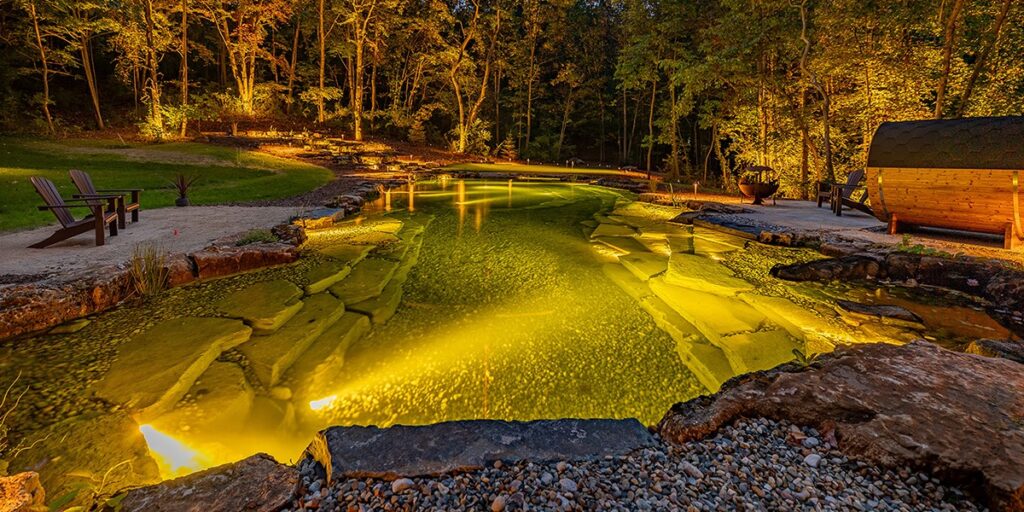
Lotus (Nelumbo) and I began a relationship some 30 years ago. Having had a childhood infused with growing things, I have always been intrigued by plants — but lotus is special. It is full of rich history, and for those with an inquisitive nature, there is boundless information since it’s one of the most researched plants in the world. It is by far one of the most attractive plants I have ever had the pleasure of growing and a magical aquatic plant.
My first encounter with Lotus was in a 20-by-40-foot natural earth-bottom pond at Kurt Bluemel’s ornamental grass and perennial nursery. The plants were without boundaries, and they had been allowed to take over the entire area. It was magnificent. The exquisite flowers were at least 12 inches wide; the immense foliage was 24 to 36 inches across. I recall a rain shower had come through, and we were given leaves for cover as we ran for shelter. They were much larger on top of you than in front of you. It was an extraordinary and memorable introduction.
Few people are willing to dedicate that much space or sacrifice the view of open water to allow a plant that much freedom. However, when they do, the outcome is magical. One of my customers many years back had a lakefront property. He wanted to plant lotus and let it be free. I warned him that since the lake was part of the community, he might get in trouble at some point. But he was unfazed.
The lake had chronic weed, water-quality and clarity issues, and he didn’t want to look at it any more. He planted, and they grew. Water quality improved, and the weeds were shaded out. He did get in a bit of trouble with the community, and they have to keep it confined to the cove once annually (in the spring) with herbicide, but he couldn’t be happier. He ended up digging multiple large ponds on his property adjacent to the lake. Each has its own lotus variety. He added roadways for his golf cart and solar night-lighting so he can enjoy the night sounds and entertain among the lotus patches.
Planting the Seed

We began growing lotus in the nursery in raised beds. Some were sectioned-off basins that collectively created a 70-by-18-foot basin within a cold frame. Others were 4-by-15-foot narrow stretches that we snuck in to small spaces around the nursery. At one point, I had a client that was working on a project that required a flowering privacy screen during August. It was the only four weeks of the year that they called their estate home. A 4-foot-wide, 100-foot-long, 2-foot-deep area was dug, tiered and lined. The surrounding soil was graded to direct rainwater toward the elongated basin to assist with maintaining the water level. A potted Mrs. Perry D. Slocum Lotus was planted every 5 feet, and within one growing season, the massive, flowering hedge row was born!
In my own backyard, I buried a landscape display container that was 36 inches in diameter and 12 inches deep without holes. I only added 3 to 4 inches of soil, which allowed for 8 inches of water above the soil line. Lotus can be tricky to get started, but once it’s growing, it is the easiest plant in my garden to care for — and you don’t need a pond to have one.
I do find that it is easier to maintain lotus in a pond because it is more accessible. The only requirement is that they don’t dry out. Since I don’t have to push the fertilizer into the soil to prevent leaching into the pond, the application is simplified. Just toss them in. The foliage covers the surface water, so algae aren’t present, either. I am rewarded with as many as 25 blooms over a period of several months, and the old flower pods make a wonderful addition to indoor arrangements.
Getting Creative
When I was in Denver at an International Waterlily and Water Gardening Symposium, there was an obvious slant to the creative use of aquatic plants in the garden and landscape. The Mile-High City presents challenges for growers of traditional annual planters. Things like geraniums and impatiens that would typically be used in planters are avoided due to the dry climate and high evaporation rates. Aquatic plants could have a self-contained reservoir that only require weekly topping off. Lotus was among the plants they chose to add to the garden in buried whiskey-barrel liners. The 15 inches of depth allowed them to winter without incident and gave them added inches to reduce the frequency for adding water. What a novel solution!

Along those same lines, I have convinced many contractors to repurpose old preformed ponds into lotus pools. They can be placed adjacent to the new pond to appear as if they were part of the pond. The diminishing edge makes the pond look larger than it is, creates a bold background and provides something of interest for reflection on the water’s surface. If planned correctly, the lotus pool can serve as a large vegetative filter for the pond simply by allowing water to trickle through it. They are heavy feeders, so even a small flow will encourage high-nutrient uptake — and they love moving water!
Lotus are quite adaptable, so raised planters are also ideal for growing them. In northern climates, dormant plants can be moved to a garage for winter protection, or straw bales can surround the container in a protected area. In warmer climates, the container choices can be more decorative. Since the range of plant sizes available covers such a broad range, the options are somewhat limitless.
An Appetizing Addition
Moreover, every part of the plant is edible and delicious. The leaves can be filled with rice and peeled seeds, folded like a wax paper sandwich and steamed, adding flavor to both. Ripe seeds can be peeled and eaten raw. Young seeds have the flavor of sweet corn crossed with fresh sweet peas. The more mature seeds have just started to change to burgundy on the tips and taste exactly like a chestnut. The tubers can be harvested in the early spring, peeled, sliced and added to stir-fry and soups. An added benefit is the thickening agent they contain. Sliced thin to 1/4 inch thick, they can be placed on a baking sheet in a medium-hot oven and baked until they start to curl. Season to taste and eat like chips. The intricate pattern of the sliced tubers adds to their interest as a food.

If it holds water, it is likely you can find a lotus that is a suitable size and color that will work to add a creative touch to the landscape, yard or table top; in or out of the pond. The visual interest they add is neverending. Truth is, they are magical no matter how you do it.



Thank you for this wonderful article. I’m experimenting with Lotus in Western new York by Niagara Falls. I started with seeds and I’m having amazing results. I’m going to overwinter them in my garage.
To ensure your success leave them outside until they are fully dormant. Allow them to recede on their own rather than cutting them back. Because you are so far north and brutally cold place them on the house wall in the garage for slightly more protection and make sure they have an adequate soil mass and plenty of water even while dormant.
Can these lotus be used in a pond bog area to filter water or contaminants?
Hello Milton,
To answer your question the short answer is yes! Absolutely. There are some parameters that need to be met for the plants to thrive and be easily maintained. If the bog is already created I would need to know the measurements and if there is filter media or gravel present. Perhaps you can contact me directly. Nelumbo22@gmail.com Lotus is used in many parts of the world for water purification, denitrification and pollution abatement very effectively.